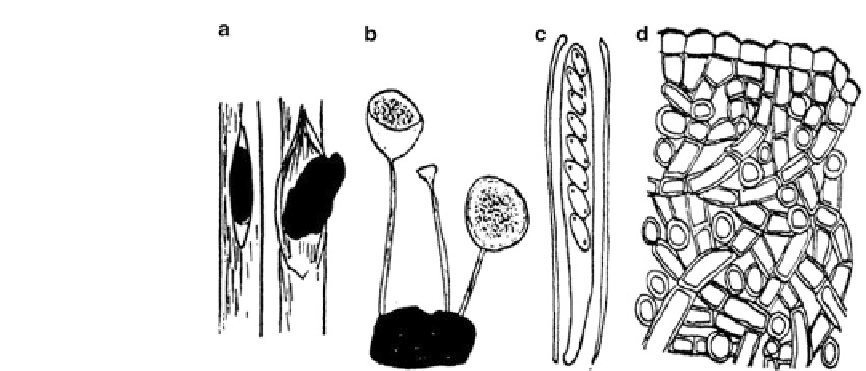Biology Reference
In-Depth Information
Fig. 9 Sclerotinia
sclerotiorum
.
(a) sclerotium formed in
pith of stem and one falling
out from broken stem;
(b) apothecia produced
from sclerotium on ground;
(c) ascus with paraphyses;
(d), section through
sclerotiorum, with colorless
medulla and dark wall on
rind cells
Resembles rot due to
S. sclerotiorum
, but sclero-
tia are much smaller.
Crown Rot
of pepper.
Sclerotinia
continuous wet weather during and after
blooming. Spraying for brown rot helps to
control green rot. Shaking or jarring trees after
bloom to remove jackets from young fruits is
suggested.
Sclerotinia sclerotiorum
Leaf and Crown
Necrosis
of African daisy;
Root Rot
and
Wilt
of
peanut.
White Mold Rot
of soybean.
Sclerotinia sclerotiorum (
S. libertiana
)
Let-
tuce Drop
,
Watery Soft Rot
of endive;
Pink Rot
of celery,
Cottony Rot
of bean, carrot, parsnip,
cabbage, and other crucifers and cucurbits. In
lettuce, older leaves wilt and fall flat on the
ground, leaving center leaves erect, but these
are soon invaded by mycelium and reduced to
a slimy wet mass. In continued moisture a thick,
white cottony mold is formed, bearing large black
sclerotia up to the size of peas (see
Fig. 9
). They
winter in the soil, send up groups of apothecia in
spring. These are brown, cup-to saucer-shaped,
up to an inch across, on a stalk. Ascospores are
ejected in a veritable cloud; there is no known
conidial stage.
Control
In commercial celery fields deep
plowing or flooding is used to inhibit apothecial
production.
Botryotinia
narcissicola
).
Narcissus Smoulder
. Perhaps the
fungus should be transferred to
Botryotinia
, since
there is a conidial stage.
Sclerotinia sclerotiorum
Black Rot
of bulbous
iris, hyacinth, narcissus and tulip. Iris fails to start
growth, or plants turn yellow, wilt, and die, often
in clumps. Bulbs are covered with thin gray
masses of mold with black irregular sclerotia
between scales. Tulip leaves develop reddish
color early in spring, wilt and die; stems and
bulbs are rotted into a crumbly mass of fragments
and black sclerotia. This is a cool-temperature
fungus that stops action about the time the heat-
loving
Sclerotium rolfsii
starts in. Remove dis-
eased plants and surrounding soil as soon as
noticed. Discard all small bulbs at harvest; plant
healthy bulbs in clean soil. The pathogen suppos-
edly dies out after 2 years in soil without suitable
host.
Sclerotinia sclerotiorum
Calyx-End Rot
on
apple and
Root and Pod Rot
of peanut,
Root
and Stem Rot
of alfalfa.
Sclerotinia sclerotiorum
Green Fruit Rot
of
almond, peach, apricot, fig and strawberry;
Rhi-
zome Rot
of ginseng. In almond, young shoots
and fruits are killed and wither soon after petals
fall. Infection takes place through jackets from
apothecia produced under trees where weeds or
crop plants have been previously infected with
cottony rot. Losses are serious only when there is
narcissicola (see
▶
Sterilize
seedbed
soil
before
planting.
Sclerotinia sclerotiorum
Stem Rot
of pepper,
cocklebur, tomato, and many
ornamentals - aconite, basil, calendula, chervil,
canola, chrysanthemum, cynoglossum, dahlia,
daisy, delphinium, Gaillardia, gazania, holly-
hock, peony, purple coneflower, snapdragon,

